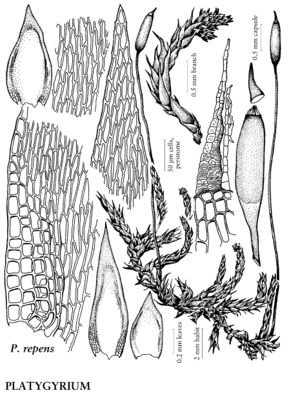Platygyrium
in P. Bruch and W. P. Schimper, Bryol. Europ. 5: 95, plate 458. 1851.
| Taxon | Illustrator ⠉ | |
|---|---|---|
 | Platygyrium repens | Patricia M. Eckel |
Plants small to large, in thin, intricate mats, yellowish to brownish or darker, glossy. Stems creeping, subpinnate; hyalodermis absent, central strand present, weak; pseudoparaphyllia filamentous or broader. Stem and branch leaves similar, ascending-imbricate to homomallous, ovate-acuminate, not to somewhat plicate; base not decurrent; margins somewhat to strongly recurved, entire to rarely slightly serrulate distally; apex acute to slenderly acuminate; costa double, short, often indistinct; alar cells differentiated, quadrate; laminal cells smooth. Specialized asexual reproduction by dehiscent brood branchlets at branch apices. Sexual condition dioicous; perichaetia small, inconspicuous. Seta reddish. Capsule erect, cylindric to subcylindric, symmetric or asymmetric, not contracted below mouth; annulus sharply differentiated, 2-seriate or 3-seriate; operculum obliquely rostrate; peristome double; exostome teeth with external surface finely papillose to papillose-striolate, smooth at apices; endostome basal membrane low or absent, segments narrowly linear, nearly as long as teeth, jointed, cilia absent. Calyptra naked. Spores round, finely granular.
Distribution
North America, Mexico, Europe, Asia, Africa
Discussion
Species ca. 8 (2 in the flora).
Platygyrium has concave leaves with yellowish bases. The alar region has vertical rows of cells with conspicuously thick walls. Platygyrium is superficially similar to Homomallium and Pylaisia. Fruiting specimens of these three similar genera are easily distinguished; the capsules of Homomallium are curved and asymmetric, often strongly so, in contrast to the erect symmetric capsules of Platygyrium and Pylaisia. The long, slender, rather obliquely rostrate operculum of Platygyrium (conspicuous when dry) distinguishes it from Pylaisia, in which the operculum is only conic or with a short blunt rostrum. Platygyrium and Pylaisia commonly grow on xylic substrates but Homomallium typically occurs on rock. Dehiscent branchlets clustered at the branch apices are very common in Platygyrium, particularly P. repens, but such branchlets also occur infrequently in Homomallium. Also, the leaf margins of Platygyrium are usually recurved, sometimes strongly so, while those of Homomallium and Pylaisia are erect. Recurvature of the leaf margins is not always well defined in P. repens but is usually conspicuous in P. fuscoluteum.
Selected References
None.
Lower Taxa
Key
| 1 | Leaves 0.8-1.1 mm, ascending to imbricate, not plicate; branches usually short, ascending, straight or curved; brood branchlets many, conspicuous. | Platygyrium repens |
| 1 | Leaves 1.3-1.6 mm, homomallous, somewhat plicate; branches elongate, creeping, straight; brood branchlets rare, inconspicuous. | Platygyrium fuscoluteum |